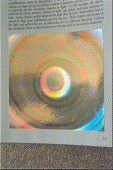|
PRIME: TOWARDS
A COLOUR THEORY, continued

Thomas
Young first reconstructed (synthesised)
white light, when projecting beams of the colours of the
spectrum onto a screen, first postulated by Newton.
By experimenting with his coloured lamps Young showed
by a process of elimination, that six colours of the spectrum
could be reduced to just three: red,
green
and dark blue.
He recorded in his notes: "Three
beams of light, one dark blue,
one intense red,
and another intense green,
when superimposed on one another, give a clear, brilliant
white light; in other words, they reconstruct light itself."
As
a result of the experiment, Young was able to identify
that there were primary and secondary colours of
the spectrum. After modifications made by Helmholtz,
it was generally held that, "the
primary colours of light are the secondary colours
of pigment, and the primary colours of pigment are
the secondary colours of light".
In full daylight, all objects receive the three
primary colours of light: red,
green
and
large amounts of dark
blue.
Some objects reflect more of the light they receive,
while others tend to absorb it; thus tonal differences
seen by the eye. Most objects absorb part of the
light, and reflect the rest, or reflect the rest
in different directions. Look at the changing
colour of the foil animation and you will see each
of the colours identified: |
|
 Textured Foil.
For highest resolution CLICK HERE
Textured Foil.
For highest resolution CLICK HERE |
|